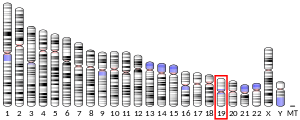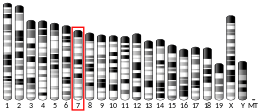Myelin-associated glycoprotein
Myelin-associated glycoprotein (MAG, Siglec-4) is a type 1 transmembrane protein glycoprotein localized in periaxonal Schwann cell and oligodendrocyte membranes, where it plays a role in glial-axonal interactions. MAG is a member of the SIGLEC family of proteins and is a functional ligand of the NOGO-66 receptor, NgR.[5] MAG is believed to be involved in myelination during nerve regeneration in the PNS[6] and is vital for the long-term survival of the myelinated axons following myelinogenesis.[7] In the CNS MAG is one of three main myelin-associated inhibitors of axonal regeneration after injury,[8] making it an important protein for future research on neurogenesis in the CNS.
Structure
MAG is a 100 kDA glycoprotein.[9] Uncleaved MAG is a complete transmembrane form, which acts as a signaling and adhesion molecule.[10] MAG can also act as a signaling molecule as a soluble protein after it has been proteolytically shed. This form of the protein is called dMAG.[11]
Adhesion
MAG has an extended conformation of five immunoglobulin (Ig) domains and a homodimeric arrangement involving membrane-proximal domains Ig4 and Ig5. MAG-oligosaccharide complex structures and biophysical assays show how MAG engages axonal gangliosides at domain Ig1.[12]
Function
Myelin-axon interactions
MAG is a critical protein in the formation and maintenance of myelin sheaths. MAG is localized on the inner membrane of the myelin sheath and interacts with axonal membrane proteins to attach the myelin sheath to the axon.[13].\ Mutations to the MAG gene are implicated in demyelination diseases such as multiple sclerosis.[14]
Inhibition of nerve regeneration
Axons in the central nervous system do not regenerate after injury the same way that axons in the peripheral nervous system do. [15] The mechanism responsible for inhibited neuroregeneration is regulated by three main proteins, one of which is MAG.[16] [17] The exact mechanism through which MAG inhibits neuroregeneration appears to be through binding of NgR. This receptor is also bound by Nogo protein, suggesting that the mechanism of myelin-associated inhibition of axon regeneration through NgR the has redundant ligands, furthering the inhibition.[18] MAG binds with high affinity to NgR, suggesting that it is equally as responsible for inhibition of axon regeneration as Nogo [19].
Rho kinase pathway
Once MAG (or Nogo) has bound to NgR, NgR activates the rho kinase (ROCK) pathway. The activation of the rho kinase pathway leads to the phosphorylation of proteins which inhibit neurite outgrowth.[20]
See also
External links
- Myelin-associated+glycoprotein at the US National Library of Medicine Medical Subject Headings (MeSH)
References
- GRCh38: Ensembl release 89: ENSG00000105695 - Ensembl, May 2017
- GRCm38: Ensembl release 89: ENSMUSG00000036634 - Ensembl, May 2017
- "Human PubMed Reference:". National Center for Biotechnology Information, U.S. National Library of Medicine.
- "Mouse PubMed Reference:". National Center for Biotechnology Information, U.S. National Library of Medicine.
- Quarles RH (March 2007). "Myelin-associated glycoprotein (MAG): past, present and beyond". Journal of Neurochemistry. 100 (6): 1431–48. doi:10.1111/j.1471-4159.2006.04319.x. PMID 17241126.
- Barton DE, Arquint M, Roder J, Dunn R, Francke U (October 1987). "The myelin-associated glycoprotein gene: mapping to human chromosome 19 and mouse chromosome 7 and expression in quivering mice". Genomics. 1 (2): 107–12. doi:10.1016/0888-7543(87)90002-4. PMID 2447011.
- Bjartmar C, Yin X, Trapp BD. "Axonal pathology in myelin disorders". Journal of Neurocytology. 28 (4–5): 383–95. doi:10.1023/a:1007010205037. PMID 10739578.
- McKerracher L, David S, Jackson DL, Kottis V, Dunn RJ, Braun PE (October 1994). "Identification of myelin-associated glycoprotein as a major myelin-derived inhibitor of neurite growth". Neuron. 13 (4): 805–11. doi:10.1016/0896-6273(94)90247-x. PMID 7524558.
- Lopez PH. "Role of myelin-associated glycoprotein (siglec-4a) in the nervous system". Advances in Neurobiology. 9: 245–62. doi:10.1007/978-1-4939-1154-7_11. PMID 25151382.
- Vinson M, Strijbos PJ, Rowles A, Facci L, Moore SE, Simmons DL, Walsh FS (June 2001). "Myelin-associated glycoprotein interacts with ganglioside GT1b. A mechanism for neurite outgrowth inhibition". The Journal of Biological Chemistry. 276 (23): 20280–5. doi:10.1074/jbc.M100345200. PMID 11279053.
- Tang S, Shen YJ, DeBellard ME, Mukhopadhyay G, Salzer JL, Crocker PR, Filbin MT (September 1997). "Myelin-associated glycoprotein interacts with neurons via a sialic acid binding site at ARG118 and a distinct neurite inhibition site". The Journal of Cell Biology. 138 (6): 1355–66. doi:10.1083/jcb.138.6.1355. PMC 2132563. PMID 9298990.
- Pronker MF, Lemstra S, Snijder J, Heck AJ, Thies-Weesie DM, Pasterkamp RJ, Janssen BJ (December 2016). "Structural basis of myelin-associated glycoprotein adhesion and signalling". Nature Communications. 7: 13584. doi:10.1038/ncomms13584. PMC 5150538. PMID 27922006.
- Lopez PH. "Role of myelin-associated glycoprotein (siglec-4a) in the nervous system". Advances in Neurobiology. 9: 245–62. doi:10.1007/978-1-4939-1154-7_11. PMID 25151382.
- Pronker MF, Lemstra S, Snijder J, Heck AJ, Thies-Weesie DM, Pasterkamp RJ, Janssen BJ (December 2016). "Structural basis of myelin-associated glycoprotein adhesion and signalling". Nature Communications. 7: 13584. doi:10.1038/ncomms13584. PMC 5150538. PMID 27922006.
- Gage FH, Temple S (October 2013). "Neural stem cells: generating and regenerating the brain". Neuron. 80 (3): 588–601. doi:10.1016/j.neuron.2013.10.037. PMID 24183012.
- McKerracher L, David S, Jackson DL, Kottis V, Dunn RJ, Braun PE (October 1994). "Identification of myelin-associated glycoprotein as a major myelin-derived inhibitor of neurite growth". Neuron. 13 (4): 805–11. doi:10.1016/0896-6273(94)90247-x. PMID 7524558.
- Mukhopadhyay G, Doherty P, Walsh FS, Crocker PR, Filbin MT (September 1994). "A novel role for myelin-associated glycoprotein as an inhibitor of axonal regeneration". Neuron. 13 (3): 757–67. doi:10.1016/0896-6273(94)90042-6. PMID 7522484.
- Domeniconi M, Cao Z, Spencer T, Sivasankaran R, Wang K, Nikulina E, Kimura N, Cai H, Deng K, Gao Y, He Z, Filbin M (July 2002). "Myelin-associated glycoprotein interacts with the Nogo66 receptor to inhibit neurite outgrowth". Neuron. 35 (2): 283–90. doi:10.1016/s0896-6273(02)00770-5. PMID 12160746.
- Liu BP, Fournier A, GrandPré T, Strittmatter SM (August 2002). "Myelin-associated glycoprotein as a functional ligand for the Nogo-66 receptor". Science. 297 (5584): 1190–3. doi:10.1126/science.1073031. PMID 12089450.
- Kaplan DR, Miller FD (May 2003). "Axon growth inhibition: signals from the p75 neurotrophin receptor". Nature Neuroscience. 6 (5): 435–6. doi:10.1038/nn0503-435. PMID 12715005.



